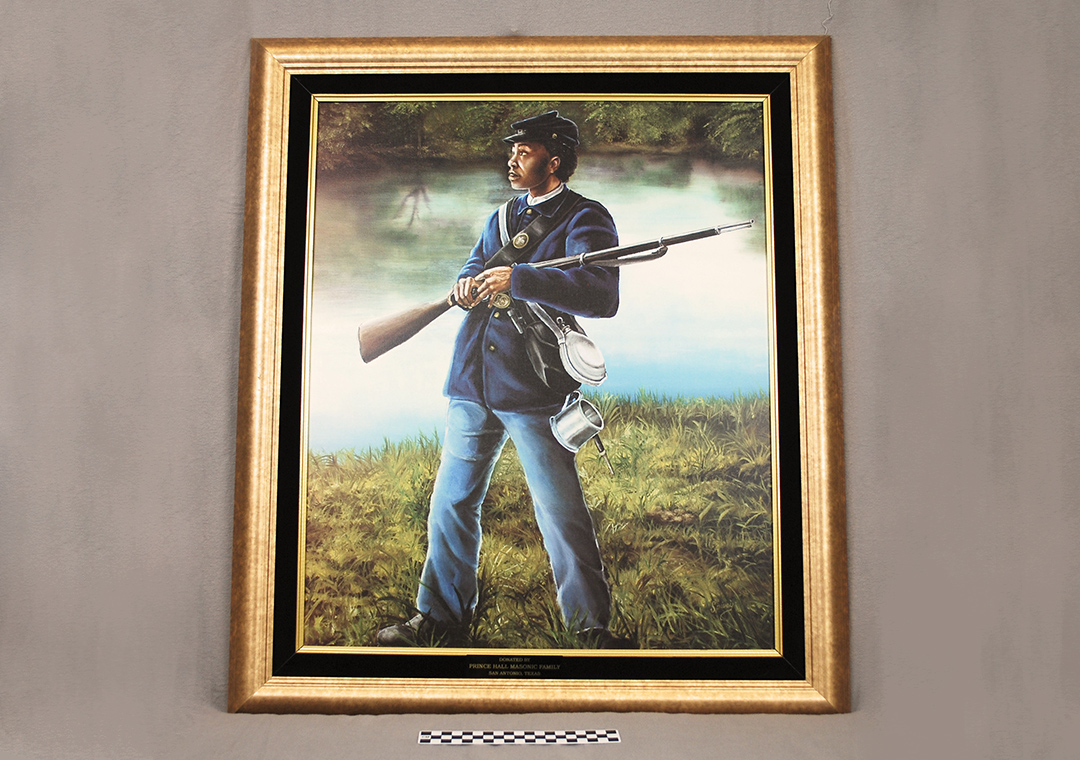This is a lithograph of a painting by Frank Spivey entitled “I am Woman.” It depicts Civil War soldier Cathay Williams, the first documented African-American woman to have served as a solider in the U.S. Army. Because U.S. Army regulations prohibited the enlistment of women into military service, Cathay Williams enlisted with the United States Regular Army on November 15, 1886 in St. Louis, Missouri as Private William Cathay. Disguised as a man, records give her age at the time of enlistment as 22 years old. She was assigned to the 38th U.S. Infantry, one of four segregated African-American units under the command of white officers. While the Union is historically portrayed as anti-slavery, officials at the time were concerned that integrating white and African-American soldiers would offend Northern conservatives. Lincoln eventually allowed for African-Americans to enlist, yet kept them segregated. During her time of service, the 38th Infantry spent time training and scouting for signs of hostiles in such locations as the Jefferson Barracks in St. Louis, Fort Harker in Kansas, and Fort Bayard in New Mexico. On October 14, 1868 she was discharged from military service with a certificate of disability. A certificate of disability allowed soldiers to end their military service due to injury. Later, the certificate could be used to obtain pension. Little else is known about Cathay, her life after the military, or her death. In June of 1891 she filed an application for invalid pension claiming she had gone deaf due to her military service. Only after she filed the claim was it revealed she was a woman. The Pension Bureau eventually rejected her claim. It is presumed Cathay Williams died between 1892 and 1900.
During the Civil War, women found several ways to contribute to the war effort on both the Union and Confederate sides as everything from spies to vivandieres – women that followed the troops and provided support. Occasionally, like Cathay, women would disguise themselves as men in order to enlist for military service. The estimated number of women who did so are somewhere between four hundred and seven hundred and fifty. It was not hard for women to pass as men during the Civil War. Men were required to pass an initial examination in order to enlist, but the exam was often very basic and women were not found out. In 1861 United States Sanitary Commission reviewed the sanitary and medical conditions of two hundred federal regiments. The commission found that 59 percent of the regiments failed to sufficiently examining their recruits at the time of enlistment. Even though soldiers lived in close proximity, they rarely removed their clothing and due to the constant movement of their regiments, the outdoors provided ample cover for bodily functions. Additionally, a number large number of young men and children enlisted, allowing women to go undetected with their higher voices and lack of facial hair. On occasion women were discovered during service when they became pregnant or during the treatment of certain wounds. When they were discovered, they were immediately discharged, though records indicate some women went to other regiments and reenlisted. When the enemy captured a female soldier, many times she was exchanged or returned to her army and then discharged.
At least five women are known to have fought at the battle of Gettysburg and ten at the battle of Antietam/Sharpsburg. A survey conducted of over two hundred and forty known female soldiers provides some information regarding their lives during service. It found that twice as many women served in the Union army compared to the Confederate army. It also showed that 15% of those female soldiers suffered wounds and they were more likely to have died on the battlefield, or from wounds received during battle, rather than from disease. The study found their term of service lasted on average 16 months and they were often promoted at a rate 14% higher than their male compatriots. Besides Cathay Williams, a few famous female soldiers during the Civil War include Sarah Edmonds who served as Franklin Thompson, Jennie Hodgers who served as Albert D. J. Cashier, and Sarah Rosetta Wakeman who served as Lyons Wakeman.
Today women who fought in the Civil War are getting more attention. There have been a good amount of books published on these women. J.R. Hardman decided to participate in Civil War reenactments and made a documentary called Reenactress about her experience. A Civil War reenactment is when individuals act out a famous battle of the civil war with fake artillery and weapons but dressed in the clothing of that period. In a effort to get the story of these women out there filmmaker Maria Agui Carter made a film about Loreta Velasquez who also fought in the Civil War.
